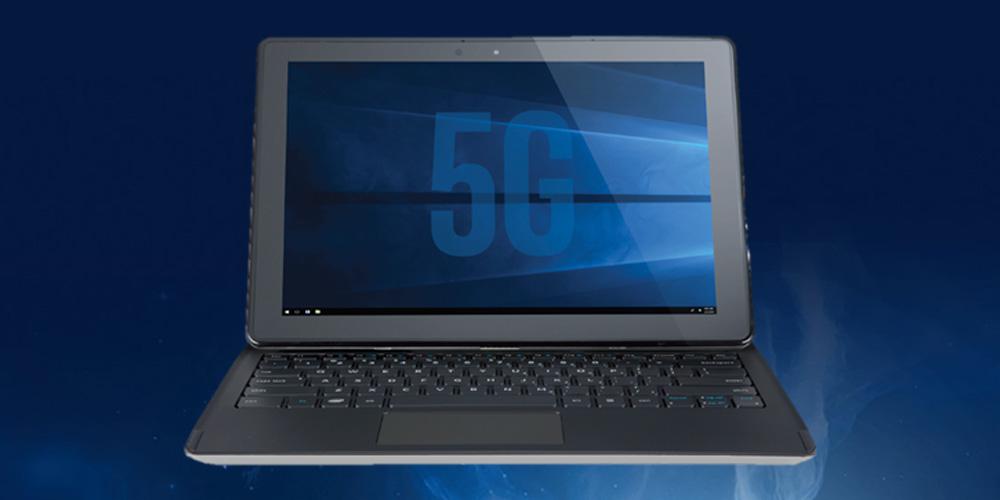Intel will be showcasing its first 5G-enabled 2-in-1 concept PC during MWC in Barcelona, which is powered by its 8th-generation Core i5 processors and an early 5G modem, and is expecting to bring 5G-connected PCs to market in the second half of 2019.
Intel announced it is collaborating with Dell, HP, Lenovo and Microsoft to bring 5G connectivity to Windows PCs with Intel® XMM™ 8000 series commercial 5G modems. Intel expects the first high-performing 5G-connected PCs to surface in the market in the second half of 2019. The PC is a central hub for processing incredible amounts of data. 5G is coming. Not only will it bring a substantial amount of data needing processing but also new experiences for PC owners.
At MWC, Intel will also showcase the latest steps it has taken to build toward a more connected future with:
- 11ax, the next big thing in Wi-Fi. A thin PC with 802.11ax Wi-Fi will be on display at the Intel’s booth in Hall 3 at Stand 3E31. 802.11ax builds enhanced levels of manageability and network efficiency, and will be a critical part of the connected future with 5G.
- eSIM functionality will be on display at Intel’s booth in Hall 3 at Stand 3E31. As of September 2017, all of Intel’s modem solutions for PCs support eSIM in enterprise and consumer segments. eSIM is an essential feature for connected PCs, and Intel plans to continue offering it going forward. Intel continues to work across the ecosystem to ensure our end customers enjoy seamless out-of-the-box experiences.
Intel is envisioning the impact 5G will deliver to businesses and consumers alike. Use cases such as autonomous vehicles, smart and connected cities, and enhanced sports viewing experiences will enrich the way we live, work and play. 5G will enable innovative service offerings unbounded by today’s infrastructure limitations and will spawn entire new industries.
Intel’s service provider customers are building the foundation for 5G and transforming their network infrastructure to take advantage of the flexibility, scalability and cost advantages of software defined networks (SDN) and network functions virtualization (NFV). These technologies enable more seamlessly connected, powerful and intelligent 5G-ready networks to be deployed in the cloud, core and edge of the network. The delivery of greater bandwidth, lower latency and edge compute capabilities are essential for 5G use cases.
Intel and industry partners are delivering innovative solutions for 5G with a foundation of Intel architecture, including the record-setting Intel Xeon Scalable platform and the recently announced Intel Xeon D-2100 system-on-chip (SOC) processor. The Xeon D-2100 extends the industry-leading capabilities of the Intel Xeon Scalable platform with power-efficient performance to meet the intensive compute, network and storage workloads demanded by 5G at the network edge. Together, this portfolio of products enables the processing, management, storage and delivery of data that continues to increase in our data-centric world.
New in the client space, collaborations with Dell, HP, Lenovo and Microsoft will enable platforms to support 5G-connected PCs with the Intel XMM 8060 modem, the first of Intel’s XMM 8000 series of commercial 5G multimode modems.
At MWC, we will be showcasing the first 5G-enabled concept 2 in 1 with a live over-the-air 5G connection to demonstrate the progress we’ve made to integrate these advanced wireless technologies into the mobile PC platform. We expect the first wave of 5G-connected PCs to be introduced to the market in the second half of 2019, building on our strong history of mobile PC connectivity leadership dating back to the first connected PC with integrated Wi-Fi in Intel Centrino.
PCs, of course, are not the only clients that will be smart and connected in the 5G era. Many of the first devices on 5G networks will be phones. To expand our entry into the China phone ecosystem, Intel and Unigroup Spreadtrum & RDA have established a multiyear collaboration to develop a portfolio of 5G products for mobile platforms, combining Intel 5G modems with Spreadtrum application processor technology. We expect Spreadtrum to launch its first 5G smartphone platform featuring an Intel XMM 8000 series modem in the second half of 2019.
Our progress in delivering 5G to the world was on full display this month at the Olympic Winter Games PyeongChang 2018. Far beyond the labs, Intel delivered with KT Corporation the world’s largest 5G deployment to date: 22 5G links at 10 sites supporting various capabilities including image capture viewpoints, IPTV, virtual reality, Wi-Fi and other telemetry. We had successful multi-vendor interoperability with new services to spectators and visitors in several Olympic venues and public areas – live links, field-tested and supporting gigabit speeds. And key insights into our work in South Korea will enable advancements of high-speed wireless to an even bigger arena in Tokyo in 2020, and help deliver even more immersive experiences.
At MWC we’re demonstrating the first 5GNR interoperability publicly. This builds on our announcement last month with Deutsche Telecom and Huawei that we conducted the world’s first successful test showcasing 5G interoperability and development testing (IODT) based on the Release 15 NSA 5G NR specification. And we are continuing additional 5G NR trials this year, including collaborations with service providers and partners around the world.
As we look to 5G commercialization in late 2019, focusing on the challenge to meet the demands of our data-centric world, you will see Intel and our partners working together to accelerate the pace of innovation and lead the market with new products, technologies, applications and experiences. Please come visit us next week at MWC, where we’re excited to share more on our vision of the 5G future. See you in Barcelona.


